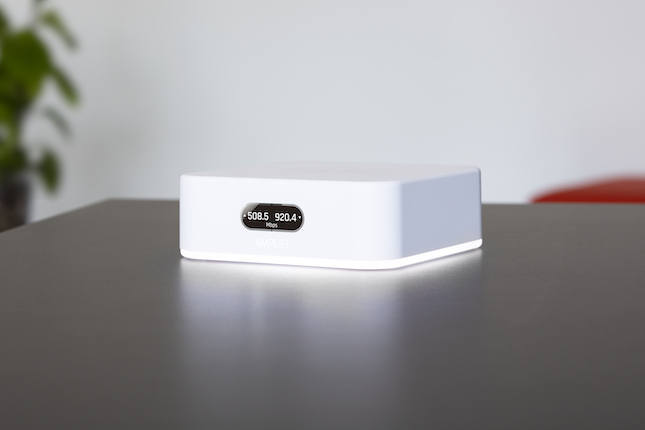

- #HOW DOES WIFI AMPLIFIERS WORK HOW TO#
- #HOW DOES WIFI AMPLIFIERS WORK MOVIE#
- #HOW DOES WIFI AMPLIFIERS WORK CODE#
- #HOW DOES WIFI AMPLIFIERS WORK PLUS#
Tap a button on the router at the same time as the device to connect to the device to the router, and we’re on. Most people connect via a WPA2 network either by sharing passwords (bad) or via WPS. WPA3 is an announced standard but is not yet a delivered standard.Īs mentioned above, WPA3 handles WiFi security differently.
#HOW DOES WIFI AMPLIFIERS WORK PLUS#
That’s a plus in the WPA2 versus WPA3 debate: WPA2 at least exists in the real world. Which means if we’re looking for a WPA3 router, we’re not going to find one because they don’t exist yet. This is how WPA3 keeps communications safe - with better encryption, better ways of setting up that encryption, and methods that keep people connecting to the network from knowing the passwords that have them on the network.Īlready on WPA2 and want to know what the difference is between WPA2 and WPA3? First of all, we can get WPA2 compliant routers right now.
#HOW DOES WIFI AMPLIFIERS WORK CODE#
Even if they also happened to speak Navajo, they’d have to know the additional code structure underneath that to understand what the message actually meant. Even if a third party could pick up the radio signals, it wouldn’t make any sense to them. It’s like the Navajo code talkers back in World War II who used codes while speaking a language no one else in the world understood. When transferring encryption keys between the router and devices, WPA3 WiFi Security uses 384-bit Hashed Message Authentication Mode so both the device and the router confirm that they can connect, but in a way where even if someone picks up the communication between them they can’t figure out what they original encryption key is.
#HOW DOES WIFI AMPLIFIERS WORK MOVIE#
Fewer times that someone has asked, “Explain the plot of the movie Inception.” There are fewer episodes of Judge Judy than that number. There is a fewer number of atoms in the known universe compared to that number. 256-bit encryption? That’s 1.15 x 10^77 - 1 with 77 zeroes following after it. In Math terms, that’s 3.048 x 10^38 - that’s 3 followed by 38 zeros after it - that’s how many calculations a computer would have to make to even guess at what the encryption key is. How big is a number like 256-bit? Previous encryption algorithms worked with 128-bit encryption. Granted, nothing lasts forever in the world of security, but WPA3 Encryption is covered by 256-bit Galois/Counter Mode Protocol (GCMP-256) so that makes breaking through the encryption harder. First, like the move of browsers Google Chrome and Firefox to warn or outright block users from connecting to insecure web servers, WPA3 security discards older encryption mechanisms in favor of ones that have not been broken.

WPA3 encryption is geared to be better than previous iterations of WiFi technology. By snapping a picture or receiving a radio signal from the router, a device can be authenticated to the network without sacrificing security. With DPP, users use QR codes or NFC tags to let devices onto the network.
#HOW DOES WIFI AMPLIFIERS WORK HOW TO#
This new system, called Wi-Fi Device Provisioning Protocol (DPP), works by transmitting how to gain access to the system without transmitting a password into the air. Rather than relying on shared passwords, WPA3 signs up new devices through processes that don’t require the use of a shared password. WPA3 security is designed to help prevent that. If there’s a shared password, then anyone who shares that with another person or writes it down runs the risk of unauthorized users getting access to the network.įor those old enough, remember that scene from the movie “Wargames” where Matthew Broderick’s character would purposely get detention so he could find the network’s password written down in a secretary’s desk? Hackers use the same technique when someone writes down the WiFi password on a Post-It on their desk to get access into the network and start capturing packets.

The biggest problem with allowing access to a local WiFi network isn’t just WiFi encryption, but how to register devices onto the WiFi network.

A person connecting via their laptop could be transmitting the passwords to their bank account over the air for a hacker to pick up. But with all this access, there is the need for WiFi network security. Today, computers and wireless networks occupy every aspect of life, from schools, hospitals, businesses, libraries - even coffee shops and buses offer WiFi access. When the first universities allowed users to connect to powerful mainframes, unruly students found ways of accessing other student’s information to play pranks on each other, requiring the creation of password protection and access rights. Every generation of computer technology spawns both new promise and new problems.


 0 kommentar(er)
0 kommentar(er)
